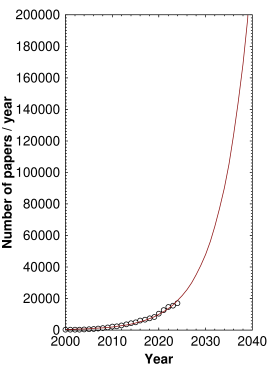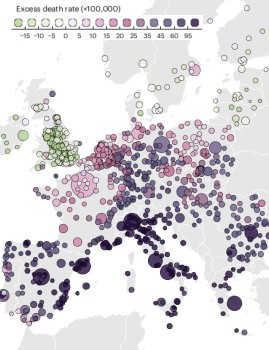 ood news! I've just run a simulation on global warming. It turns out that
by extrapolating at the current rate, there will be 24,816,124,721.74 papers
per year by 2100 about global warming or climate change in the scientific
literature. Also, most of us will be dead.
ood news! I've just run a simulation on global warming. It turns out that
by extrapolating at the current rate, there will be 24,816,124,721.74 papers
per year by 2100 about global warming or climate change in the scientific
literature. Also, most of us will be dead.

Global warming papers, 2000–2040
By 2200, there will be 2.199495 × 1018 per year, for a total of 1.579 × 1019 papers. At ten pages per paper and 8.5 × 11 inches per page, that's enough to cover the entire planet with papers about global warming 24.17 centimeters thick.
Due to their high reflectivity, this means the Earth will be plunged into an irreversible ice age. Mar-A-Lago will be under six miles of ice. So will Nature's editorial offices in the UK.
How is this good news, you ask? Easy. We'll all die of boredom long before then. Also, all those maps with areas highlighted in dark red and orange will absorb some visible light, mitigating the effect slightly. However, some of the papers might be printed on A4, which is slightly bigger and more reflective.
I mention Nature because they just published another paper (open access—congrats for that) describing a computer model that claims that 2,345,410 people in Europe will die of global warming, which the authors call “extreme temperatures both hot and cold,” by the end of the century. It must be true: they have a map with really dark black and purple colors on it. One does not argue with purple!
Its stated goal is to refute the idea that cold kills ten times as many humans as heat. This has been a long-standing embarrassment to climate alarmists. The other goal is to reduce global warming to illness and death so GW can be portrayed as a public health problem. All they've shown so far is if it someday gets hot enough to kill people, people might die. That 2.3 million figure is really little more than CAS: computer aided speculation. It also assumes four degrees C warming, which no sensible person thinks could ever happen.*
There's not much science in the article. The best one can say about these numbers is that they're “soft.” They're extrapolations based on a large number of assumptions, including demographic aging, “mitigation”, and the CO2 hypothesis, that may or may not be valid. The authors are from places like the European Commission Joint Research Centre, the Oeschger Center for Climate Change Research, and the CICERO Center for International Climate Research. Weirdly, it's in The Lancet Planetary Health,[1] but an almost identical article by the same authors is now in Nature Medicine,[2] which people actually read.

Excess deaths by global warming by 2100 with 4 degrees of warming as predicted by Masselot's computer model [1]
The UK Daily Mail has an article that used the same methodology as the Lancet authors, which is to say assume some improbably large effect of global warming and ask what scary things would occur. They asked an AI program to “Show me what it would look like in the year 2100 where sea levels have risen 6.2 feet.” The results are a lot more entertaining.
Bangkok, Thailand will have a circular highway about a mile in diameter that goes nowhere, as if somebody designed an enormous traffic circle with a single entrance ramp but no exit. In the future, the computer is saying, engineers will be so exhausted from swimming to work they'll no longer care. People will get on this highway and drive around forever but never get off, as in that old pre-woke Doctor Who episode with flying cars stuck underground in an enormous traffic jam in New New York in the year five billion.
Another one shows Ho Chi Minh City where a luxury yacht is barrelling full speed ahead, mere seconds from T-boning a Chinese junk. Behind it, two ferries are hurtling directly toward each other, headed for catastrophe. In the background we have one of those dead-end overpasses that will be common in the future where the bridge ends abruptly, sending cars to a fiery doom. There are many trees, perfectly green and healthy, growing in the water. The whole scene has a definite Lathe of Heaven** vibe to it.
Another article is based on claims by Climate Central, which is a 501(c)(3) that calls itself a “climate communications group”, i.e. a global warming propaganda outlet. These guys predict that Mar-A-Lago will be underwater by 2100, an unsubtle dig at President Trump. They also claim the Arctic will be “free of ice” by 2027—two years from now—despite the dismal history of such predictions and their own graph showing that 2024 was smack in the historical middle of the pack.
Warming skeptics sometimes say AGW is so vague it's non-falsifiable. This is not strictly true. A theory is falsified when it makes a prediction that does not happen. Predictions about global warming have proved false again and again. It's just that the activists don't accept the logical conclusion that the theory must be wrong. In their own terminology, they're “deniers.”
Unfortunately, for many people AGW is tied to a form of group politics that says you're a good person if you believe it's true and a bad person if you don't. It's almost impossible to reason somebody out of believing something that tells them they're a good person. This has been the human weakness throughout history.
When you make vast numbers of risky predictions, you're tempting the god of modus tollens: If A implies B, then not-B proves that A is false. In a real science, a single incorrect prediction destroys a theory. As the number of predictions increases, the probability of a theory crashing and burning approaches 1.0. If you change the prediction when the theory fails, it means your goal isn't to discover the truth, but to protect the theory by any means possible.
In science, you only learn when a theory fails. That's how physicists discovered the Higgs boson. It's good news because it means the field can advance. When a theory isn't allowed to fail but has to be propped up with jury-rigged models, it means if what you're doing is supposed to be science, you're doing it wrong.
* Note added Feb 03, 2025: The number 2,345,410 comes from the “lowest mitigation and adaptation scenario” and is their total estimated deaths from 2015 (not a typo) and 2099. The authors claim a 95% confidence interval of 327,603 to 4,775,853 for their prediction. Other scenarios range from 616,798 to 636,798 depending on the level of “adaptation” and “mitigation.” All these numbers appear to be based on computer models that consist mainly of extrapolations from the authors' previous estimates of “temperature-related mortality,” such as in their Lancet Planet Health paper.[1]
This 95% confidence range is what scientists call “really big.” Where's Ioannidis when we need him?
** In Ursula K. Le Guin's The Lathe of Heaven, a drug addict discovers that his fever dreams become reality. He uses it to dream about peace and fighting global warming, but everything he dreams happens by way of some horrible catastrophe. By focusing only on the desired end result, he almost destroys reality. The world in the story becomes more and more weird, with nuclear wars happening and unhappening and extraterrestrials running coffee shops.
[1] Masselot P, Mistry M, Vanoli J, Schneider R, Iungman T, Garcia-Leon D, C iscar JC, Feyen L, Orru H, Urban A, Breitner S, Huber V, Schneider A, Samoli E, Stafoggia M, de'Donato F, Rao S, Armstrong B, Nieuwenhuijsen M, Vicedo-Cabrera AM, Gasparrini A; MCC Collaborative Research Network; EXHAUSTION project. Excess mortality attributed to heat and cold: a health impact assessment study in 854 cities in Europe. Lancet Planet Health. 2023 Apr;7(4):e271-e281. doi: 10.1016/S2542-5196(23)00023-2. Erratum in: Lancet Planet Health. 2024 Aug;8(8):e531. doi: 10.1016/S2542-5196(23)00171-7. PMID: 36934727.
Update, Feb 03, 2025: A virtually identical paper titled Estimating future heat-related and cold-related mortality under climate change, demographic and adaptation scenarios in 854 European cities is in Nature Medicine 2025. It is now indexed in Pubmed.[2]
[2] Masselot P, Mistry MN, Rao S, Huber V, Monteiro A, Samoli E, Stafoggia M, de'Donato F, Garcia-Leon D, Ciscar JC, Feyen L, Schneider A, Katsouyanni K, Vicedo-Cabrera AM, Aunan K, Gasparrini A. Estimating future heat-related and cold-related mortality under climate change, demographic and adaptation scenarios in 854 European cities. Nat Med. 2025 Jan 27. doi: 10.1038/s41591-024-03452-2. PMID: 39870815.
jan 29 2025, 4:53 am. last updated feb 03 2025, 4:39 am
